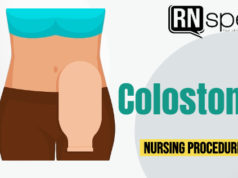Establishing a patent airway is top priority in all clients. In cases where endotracheal intubation or tracheotomy cannot be performed immediately to establish airway, it is necessary to perform a cricothyrotomy. This procedure is rarely performed and is done by puncturing the trachea through the cricithyroid membrane.
The physician performs this procedure and the role of the nurse is to assist. However, in emergent cases and if the physician is not available, a trained nurse can perform cricothyrotomy procedure if the patient is likely to die before intubation is possible. In ideal situations, cricothyrotomy is performed using a sterile technique but during emergent situations this may not be strictly possible.
Equipment Needed:
Scalpel or needle cricothyrotomy
- Sterile gloves
- Povidone iodine solution
- Sterile gauze pads, 4×4
- Dilator
- Tape
- Oxygen source
Scalpel cricothyrotomy
- Scalpel
- Tracheostomy tube
- Handheld resuscitation bag or T tube and wide-bore oxygen tubing
Needle cricothyrotomy
- 14G or larger through-the-needle or over-the-needle catheter
- 10 ml syringe
- IV extension tubing
- Hand-operated release valve or pressure-regulating adjustment valve
Cricothyrotomy Procedure
Pre-procedure
- Hyperextend the patient’s neck to expose the area of the incision site.
- Ask someone to hold the patient’s head in the correct position while performing the procedure.
- Wash hands, don sterile gloves to prevent transmission of harmful microorganisms.
- Clean patient’s neck with a sterile gauze soaked in povidone iodine solution. Use circular strokes starting at the middle of the incision site outwards, to reduce the risk of contamination.
- Locate the accurate incision site. This is done by sliding the thumb and fingers down the thyroid gland. You have located the outer boarders of the thyroid glands when the space between the fingers and thumb widens.
- Move your fingers to the center of the gland, over the anterior edge of the cricoid ring.
If using a scalpel:
- Make an incision horizontally about 1.3 cm or less than 0.5 inches long in the cricothyroid membrane just about the cricoid ring.
- To keep the tissue from closing around the site of incision, use a dilator. In case a dilator is not available, use the handle of scalpel – insert it to the incision and rotate to about 90 degrees.
- Insert a tracheostomy tube (#6 or smaller) to the opening. Make sure to secure it to maintain a patent airway. In cases where a tracheostomy tube is not available, you can tape the dilator or scalpel handle in place until a tracheostomy tube is available.
- Attach a humidified oxygen source to the tracheostomy tube if the patient can breathe spontaneously. If the patient cannot breath, attach a handheld resuscitation bag. Inflate the cuff of the tracheostomy tube using a syringe to provide a positive-pressure ventilation.
- Auscultate for breath sounds bilaterally and check the patient’s vital signs.
- Dispose gloves and wash hands.
If using a needle:
- Attach a 10 ml syringe to a 14G or larger through-the-needle or over-the-needle catheter. Insert the catheter into the cricothyroid membrane just above the cricoid ring.
- At a 45-degree angle, insert the catheter downwards to the trachea. This technique keeps the vocal cords from injury. Maintain a negative pressure by pulling the plunger of the syringe back as the catheter advances. You will know the catheter entered the trachea when air enters the syringe.
- When the catheter is at the trachea, advance it and remove the needle and syringe. Then tape the catheter in place.
- The catheter hub is then attached to one end of IV extension tubing. The other end is attached to the hand-operated release valve or a pressure-regulating adjustment valve and connect the entire assemble to the oxygen source.
- To introduce oxygen to the trachea and inflate the lungs, press the release valve. When inflated, release the valve to allow passive exhalation. Adjust the pressure-regulating valve to the minimum pressure needed for adequate lung inflation.
- Auscultate breath sounds bilaterally and check the vital signs.
- Dispose gloves and wash hands.
After the procedure, it is important to check the incision site for bleeding, subcutaneous emphysema or inadequate ventilation and damage of the tracheal or vocal cord. For patients under 12 years old, scalpel cricothyrotomy is not advisable as it could damage the cricoid cartilage which is the only circumferential support to the upper trachea. Again, this procedure should only be performed by a physician or in emergent situations a trained nurse.
Resource: Best Practices, Lipincott Williams and Wilkins



![Caring for Patients with Tracheostomy and Nursing Diagnoses [ Updates] tracheostomynursingprocedure](https://rnspeak.com/wp-content/uploads/2020/10/tracheostomynursingprocedure_725820712-238x178.jpg)



